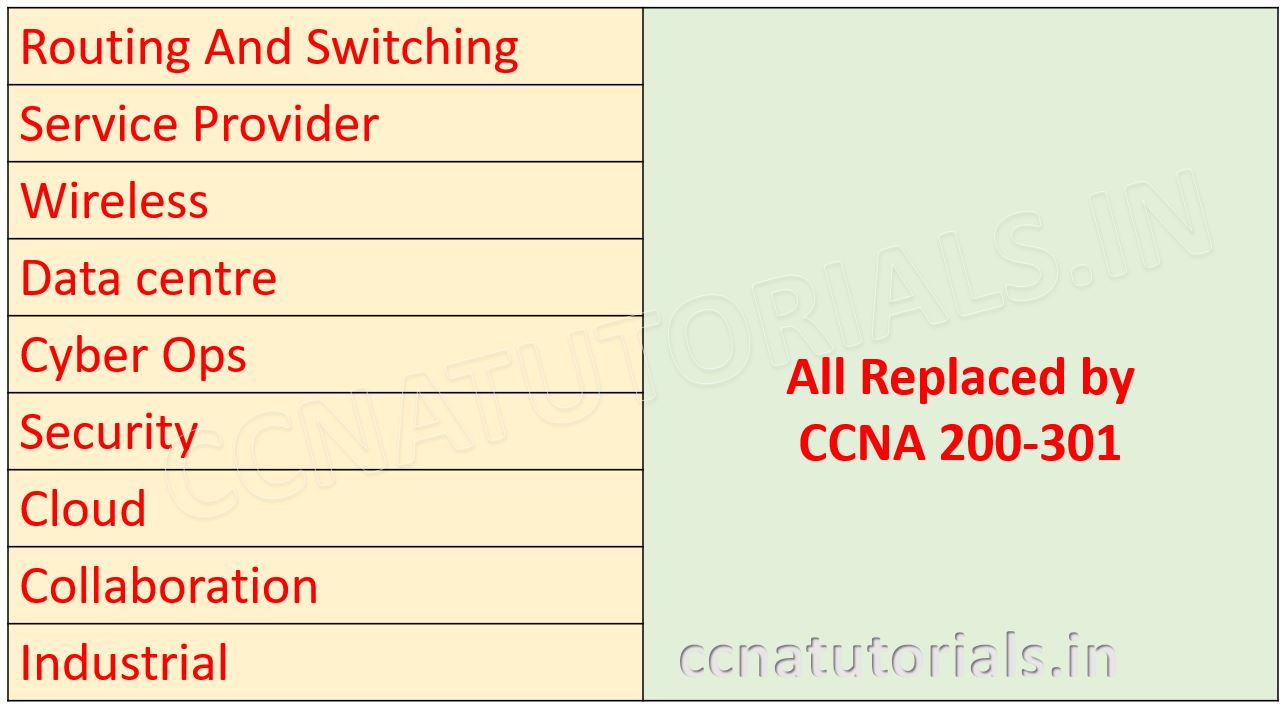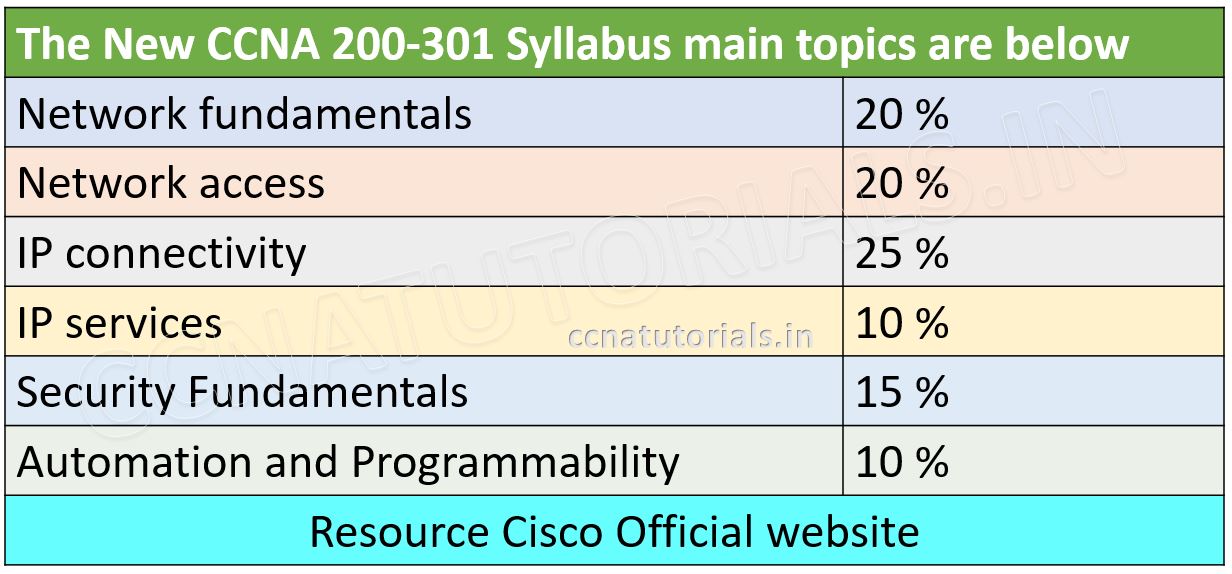Contents of this article
In this article I describe the New CCNA 200-301 Syllabus. The New CCNA 200-301 Syllabus announced by Cisco Officials on 24 Feb 2020. Cisco certifications changes the syllabus time to time due to new technology come day by day. On 24 Feb 2020 Cisco certifications announce the New CCNA 200-30 Syllabus. The newly changed syllabus need a depth knowledge of networking fundamentals.
The CCNA 200-301 course syllabus consist the networking fundamentals. You have to learn the basic things related to networking. Cisco released the syllabus for CCNA 200-301 which is combination of Cisco associate courses. You will learn the subnetting, configuration of IP addresses, and configuration of VLANs etc. New CCNA 200-301 course required both theory and practical knowledge. Configuration, testing and troubleshooting of networking devices can be learn by New CCNA 200-301 course syllabus. You can use Cisco Packet Tracer software for practice with networking devices like live environment.
Networking in IT is the fastest growing field today. As number of users and devices increased day by day. The concern of data speed and security is related to networking. The demand of skills increased to handle the current network concern. The New CCNA 200-301 Syllabus contains the fundamental of networking like IP routing, network access, network security, IP connectivity etc.

Old vs New CCNA 200-301 syllabus pattern
Before 24 Feb there are many domains covered by CCNA certification. The old certifications domains are Cloud, Collaboration, Data Center, Industrial, Routing and Switching, Security, Service provider and wireless. Each domain set for a separate syllabus from each other. The New CCNA. After 24 Feb there will only one single CCNA exam replaced these all domains. So now there is only single exam for new comers in the field of networking. The exam code remains 200-301. Now the main focus of CCNA 200-301 exam is on IP fundamentals, IP connectivity, Automation, Network Access and Security.
Topics of New CCNA 200-301 syllabus resource
the resource of this information is cisco official site link is https://learningnetwork.cisco.com/s/ccna-exam-topics. The new topics added are shown in the bold format with red colour. The basic 6 topics with percentage of exam are shown in below image.

The bold and red contents are newly added topics in New CCNA 200-301 syllabus
Network Fundamentals 20%
1.1 Explain the role and function of network components
1.1.a Routers
1.1.b L2 and L3 switches
1.1.c Next-generation firewalls and IPS
1.1.d Access points
1.1.e Controllers (Cisco DNA Center and WLC)
1.1.f Endpoints
1.1.g Servers
1.2 Describe characteristics of network topology architectures
1.2.a 2 tier
1.2.b 3 tier
1.2.c Spine-leaf
1.2.d WAN
1.2.e Small office/home office (SOHO)
1.2.f On-premises and cloud
1.3 Compare physical interface and cabling types
1.3.a Single-mode fiber, multimode fiber, copper
1.3.b Connections (Ethernet shared media and point-to-point)
1.3.c Concepts of PoE
1.4 Identify interface and cable issues (collisions, errors, mismatch duplex, and/or speed)
1.5 Compare TCP to UDP
1.6 Configure and verify IPv4 addressing and subnetting
1.7 Describe the need for private IPv4 addressing
1.8 Configure and verify IPv6 addressing and prefix
1.9 Compare IPv6 address types
1.9.a Global unicast
1.9.b Unique local
1.9.c Link local
1.9.d Anycast
1.9.e Multicast
1.9.f Modified EUI 64
1.10 Verify IP parameters for Client OS (Windows, Mac OS, Linux)
1.11 Describe wireless principles
1.11.a Nonoverlapping Wi-Fi channels 1.11.b SSID 1.11.c RF 1.11.d Encryption
1.12 Explain virtualization fundamentals (virtual machines)
1.13 Describe switching concepts
1.13.a MAC learning and aging
1.13.b Frame switching
1.13.c Frame flooding
1.13.d MAC address table
Network Access 20%
2.1 Configure and verify VLANs (normal range) spanning multiple switches
2.1.a Access ports (data and voice)
2.1.b Default VLAN
2.1.c Connectivity
2.2 Configure and verify interswitch connectivity
2.2.a Trunk ports
2.2.b 802.1Q
2.2.c Native VLAN
2.3 Configure and verify Layer 2 discovery protocols (Cisco Discovery Protocol and LLDP)
2.4 Configure and verify (Layer 2/Layer 3) EtherChannel (LACP)
2.5 Describe the need for and basic operations of Rapid PVST+ Spanning Tree Protocol and identify basic operations
2.5.a Root port, root bridge (primary/secondary), and other port names
2.5.b Port states (forwarding/blocking)
2.5.c PortFast benefits
2.6 Compare Cisco Wireless Architectures and AP modes
2.7 Describe physical infrastructure connections of WLAN components (AP, WLC, access/trunk ports, and LAG)
2.8 Describe AP and WLC management access connections (Telnet, SSH, HTTP, HTTPS, console, and TACACS+/RADIUS)
2.9 Configure the components of a wireless LAN access for client connectivity using GUI only such as WLAN creation, security settings, QoS profiles, and advanced WLAN settings
IP Connectivity 25%
3.1 Interpret the components of routing table
3.1.a Routing protocol code
3.1.b Prefix
3.1.c Network mask
3.1.d Next hop
3.1.e Administrative distance
3.1.f Metric
3.1.g Gateway of last resort
3.2 Determine how a router makes a forwarding decision by default
3.2.a Longest match
3.2.b Administrative distance
3.2.c Routing protocol metric
3.3 Configure and verify IPv4 and IPv6 static routing
3.3.a Default route
3.3.b Network route
3.3.c Host route
3.3.d Floating static
3.4 Configure and verify single area OSPFv2
3.4.a Neighbor adjacencies
3.4.b Point-to-point
3.4.c Broadcast (DR/BDR selection)
3.4.d Router ID
3.5 Describe the purpose of first hop redundancy protocol
IP Services 10%
4.1 Configure and verify inside source NAT using static and pools
4.2 Configure and verify NTP operating in a client and server mode
4.3 Explain the role of DHCP and DNS within the network
4.4 Explain the function of SNMP in network operations
4.5 Describe the use of syslog features including facilities and levels
4.6 Configure and verify DHCP client and relay
4.7 Explain the forwarding per-hop behavior (PHB) for QoS such as classification, marking, queuing, congestion, policing, shaping
4.8 Configure network devices for remote access using SSH
4.9 Describe the capabilities and function of TFTP/FTP in the network
Security Fundamentals 15%
5.1 Define key security concepts (threats, vulnerabilities, exploits, and mitigation techniques)
5.2 Describe security program elements (user awareness, training, and physical access control)
5.3 Configure device access control using local passwords
5.4 Describe security password policies elements, such as management, complexity, and password alternatives (multifactor authentication, certificates, and biometrics)
5.5 Describe remote access and site-to-site VPNs
5.6 Configure and verify access control lists
5.7 Configure Layer 2 security features (DHCP snooping, dynamic ARP inspection, and port security)
5.8 Differentiate authentication, authorization, and accounting concepts
5.9 Describe wireless security protocols (WPA, WPA2, and WPA3)
5.10 Configure WLAN using WPA2 PSK using the GUI
Automation and Programmability 10%
6.1 Explain how automation impacts network management
6.2 Compare traditional networks with controller-based networking
6.3 Describe controller-based and software defined architectures (overlay, underlay, and fabric)
6.3.a Separation of control plane and data plane
6.3.b North-bound and south-bound APIs
6.4 Compare traditional campus device management with Cisco DNA Center enabled device management
6.5 Describe characteristics of REST-based APIs (CRUD, HTTP verbs, and data encoding)
6.6 Recognize the capabilities of configuration management mechanisms Puppet, Chef, and Ansible
6.7 Interpret JSON encoded data
So you will learn from basics to configure the routing protocols like OSPF, EIGRP, configuration of VLAN, IPv4 and IPv6 and much more the basic things of networking.
The above topics released by CISCO Official website. I hope you found this article helpful. For any query or suggestion you may drop a comment below or contact us. Your suggestions are always welcome by us. Good luck







You write an amazing blog. it is very helpful for me. thank you for such great information.
Amazing
Info was on point. Love to read more about Networking.